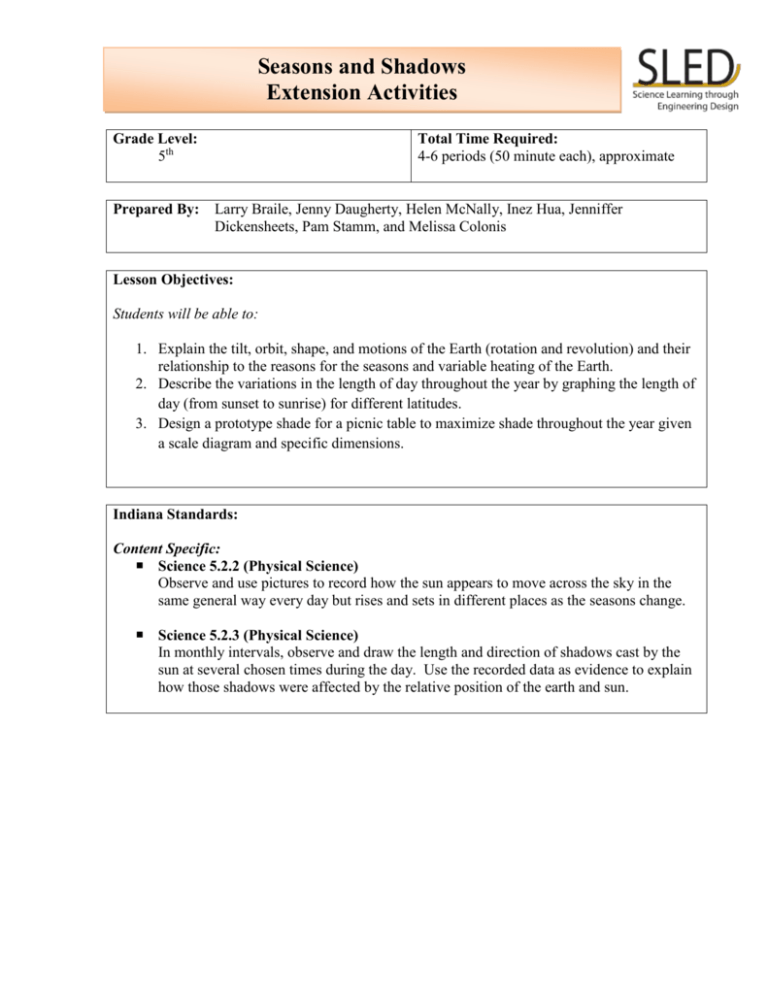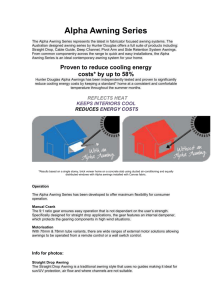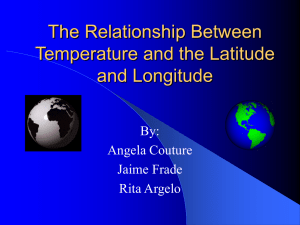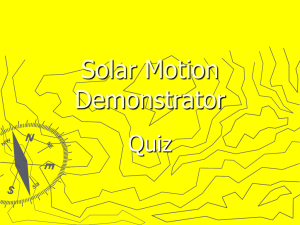2012_Lesson_Plan_Reasons_for_Seasons_Additional_Activities
advertisement

Seasons and Shadows Extension Activities Grade Level: 5th Prepared By: Total Time Required: 4-6 periods (50 minute each), approximate Larry Braile, Jenny Daugherty, Helen McNally, Inez Hua, Jenniffer Dickensheets, Pam Stamm, and Melissa Colonis Lesson Objectives: Students will be able to: 1. Explain the tilt, orbit, shape, and motions of the Earth (rotation and revolution) and their relationship to the reasons for the seasons and variable heating of the Earth. 2. Describe the variations in the length of day throughout the year by graphing the length of day (from sunset to sunrise) for different latitudes. 3. Design a prototype shade for a picnic table to maximize shade throughout the year given a scale diagram and specific dimensions. Indiana Standards: Content Specific: Science 5.2.2 (Physical Science) Observe and use pictures to record how the sun appears to move across the sky in the same general way every day but rises and sets in different places as the seasons change. Science 5.2.3 (Physical Science) In monthly intervals, observe and draw the length and direction of shadows cast by the sun at several chosen times during the day. Use the recorded data as evidence to explain how those shadows were affected by the relative position of the earth and sun. Lesson Plan #4 Design Activity 2: Build an awning to take advantage of solar heating and cooling Time: One 50 minute class period (depending on students’ familiarity with angles, using a protractor, and the engineering design process) Now that we have learned about the movements of the Earth, and the Earth’s tilt and resulting seasons and variations in heating caused by the seasons and related to location (latitude), we would like to make use of this knowledge to design an awning to take advantage of solar heating and cooling for a south-facing window of a building. Humans have understood and utilized shading and passive solar heating (allow Sun to heat an area in winter) and cooling (provide shade from the Sun in the summer) for a long time. For example, the Anasazi Indians of the southwestern U.S. built cliff dwellings under south facing overhangs or steep cliffs so that the buildings would be heated by the Sun in winter months and would be shaded from the hot Sun during summer months (Figure 4.) Figure 4. Left – The Anasazi Indians of the southwestern U.S. (mostly in Arizona, New Mexico and Colorado) used passive solar concepts about a thousand years ago to design their dwellings. Right – Photo of a typical fixed awning used for shading. The front edge of the awning is usually at the elevation of the top of the window so that visibility out the window is not overly restricted. The amount of shading is then determined by the distance of this edge from the wall (the length of the awning. Break up the class into teams – one team for each latitude (and Sun Angle; see Table 1 in Design Activity 1; 75o N, 60o N, 40o N, 20o N, 0o [equator], 40o S). Provide each of the six teams with copies of Design Activity 2 and related materials and work pages. The shading of the window for various Sun angles can be tested using the flashlight held at different angles above the horizontal (horizon). Each team should try to design a shade or an awning for their latitude that meets the goals and constraints of the design challenge (Design Activity 2). Using the flashlight to illuminate (as the Sun’s rays would) the shaded table or the window area and measuring the angle of the light relative to the vertical direction is illustrated in Figure 5. Figure 5. Left – Use of a flashlight to illuminate a model. Right – The angle of the flashlight (90 - As ) can be measured and the flashlight angle adjusted using a protractor taped to the flashlight as shown here. Next, if you are using Design Activity 2, have each team design an awning for their latitude using Work Page 2. The Sun angles for 40 degrees N are illustrated on this work page as an example. Each group should use their specific latitude to determine the appropriate Sun angles. How long does the awning have to be to meet the specifications given on the work page? To determine the awning length, have the students place the protractor horizontally on the figure with the center hole at the head of the arrow on the window as illustrated in Figure 13. The angles (“high Sun angle” and “low Sun angle”) can then be drawn to determine the awning length for their latitude and the specifications. Have each team share their shade or awning information and designs with the entire class and demonstrate that they work (according to the design goals) for their latitude. Design Activity 2 Seasons and Shadows – Shade My Space Image obtained from: http://parkinglotconfessional.com/2010/11/29/sunnyside-up/ Design and Construct an Awning Design Challenge: “Can you construct an awning to maximize light and shade?” Molly decided to move her desk over to the South facing wall in her bedroom so she can have more light and can look outside while she is studying. However, she soon discovered that right when she gets ready to do her homework there is a strong glare on her computer screen and it gets pretty warm then too. Can you help Molly enjoy the view and still get plenty of light in the room from the sun, but prevent the glare and some of the heat? Your task is to work in a team to design and construct an awning that Molly’s parents can place outside of her window. In order to help her parents build the best awning, you will provide them a small scale (prototype) of the awning at the correct scaled dimensions. The prototype awning should: Maximize the shade and light for Molly’s window according to the design specifications Be constructed from the materials provided Be at the appropriate scale given the dimensions provided An awning over a window provides many benefits. During the summer, the awning blocks much of the sunlight before it goes through the window, and reduces the amount of heating inside the house. This reduces the amount of time that the air conditioner has to run to keep the house comfortable, and saves energy. During the winter, with a properly sized awning, more sunlight is able to go through the window, and heat the house up. This reduces the amount of time that the heater has to run, and saves energy. In both cases, the energy savings directly results in saving money, because the energy bill is less. Another very important benefit of using less energy is that it conserves fuel. In many cases, fuels such as natural gas, heating oil, or coal release carbon dioxide into the atmosphere. Carbon dioxide contributes to global climate change. So, because awnings help maintain a comfortable temperature inside a home or building during many seasons, it helps save energy and reduce our contributions to climate change. (An extension of this design task is to refine your design to allow for adjustable shading so that the awning can be used at any Sun angle (any time of day and in any season or time of the year.) Work Page 1: Template for 3-D Building and Window (Design Activity 2) – Fold ends of paper back at the two dashed lines to form wall of building. ----------------------------------------------------------------------------------------------------------------------------- ----------------------------------------------------------------------------------------------------------------------------- Work Page 2 (Design Activity 2): Determine extension length of awning for this location and specifications. Noontime solar angles are shown for summer and winter solstices (40 degrees N latitude). How wide does an awning have to be to provide shade for the entire window at about noon on June 21 and allow at least 80% of the window to be not shaded at about noon on December 21? Select Sun angles for your latitude. Lesson Plan #4 Follow-up Activities – Length of day calculation and graphing, average monthly temperatures at different latitudes graphing Time: One to two 50 minute periods (depending on students’ experience with graphing) Procedures / Steps: Preparation: Print copies of student work pages (3-6), one set for each group Objective: Students will determine length of day in hour form for a given latitude on the 21st day of each month and use that information to make a graph. Assign each group of students one of the following latitudes: 75 degrees N, 60 degrees N, 40 degrees N, 20 degrees N, 0 degrees (equator), 40 degrees S. Have each group students go to website (http://aa.usno.navy.mil/data/docs/RS_OneYear.php) to find the sunrise and sunset times for their group’s given latitude. Go to Form B of the website. Enter the Longitude 87 (West) and the Latitude (one of the selections from above list). Select North or South Latitude as appropriate. For time zone, enter 5 (West of Greenwich). Click on Compute Table. In the resulting Table of sunrises and sunsets, highlight the row that corresponds to day 21 of each month. Transfer these sunrise and sunset times to Table 3 (work page 3). In Table 3, record the sunrise and sunset times for the 21st day of each month. Then, change each standard time to military time (students may need to review the mini-lessons, below, for this and additional conversions of these numbers). In Table 4 (work page 4), calculate elapsed time (from sunrise to sunset), which represents the amount of sunlight of 21st day of each month. Then, change the elapsed time (in hours and minutes) to hours by converting the fraction representing minutes to a decimal. Graph (Graph 1, work page 5) Month (1 through 12) vs. Length of Day (in hours). Finally, calculate the average length of day for your latitude by adding the length of day (hours) for the 12 months and divide by 12. Compare your group’s graph of length of day and average length of day with the results from other groups. A PowerPoint containing Excel graphs of the length of day for each latitude (separately and all on one graph) is available at: http://web.ics.purdue.edu/~braile/new/LengthOfDay.pptx Average monthly temperature data and graphs for different latitudes IAS 6.6.1: Organize and display single-variable data in appropriate graphs and stem-and-leaf plots, and explain which types of graphs are appropriate for various data sets. IAS 5.7.1: Analyze problems by identifying relationships, telling relevant from irrelevant information, sequencing and prioritizing information, and observing patterns. IAS 6.7.1: Analyze problems by identifying relationships, telling relevant from irrelevant information, identifying missing information, sequencing and prioritizing information, and observing patterns. IAS 6.7.2: Make and justify mathematical conjectures based on a general description of a mathematical question or problem. Now that you understand how to make a line graph, you will have a chance to record and graph the average temperatures for each month of the year for your particular city. By observing the average monthly temperatures at different times of the year (seasons) and at different latitudes (yours and those from the other teams), we will be able to see the combined effects of seasons and latitudes on solar heating of the Earth’s atmosphere. To find the temperature data, go to the website, http://weatherbase.com/. Once you are there do the following: 1. Select one city you will use to record average monthly temperatures (select degrees C on the web page). You will select from the following cities (and latitudes): a. Barrow, Alaska (~71 degrees N) b. Anchorage, Alaska (~61 degrees N) c. Lafayette, Indiana (~40 degrees N) d. San Juan, Puerto Rico (~18 degrees N) e. Manta, Ecuador (~0 degrees, equator) f. Valdivia, Chile (~40 degrees S) 2. Fill in the “Average Monthly Temperature” chart (use degrees C, Table 5). 3. Use the information to create a line graph. 4. Answer the following questions: a. Describe the pattern that you observe? b. Can you identify winter and summer seasons from the temperature data? 5. Now, compare with a group who used a different city. Answer these questions: a. What differences do you see between the graphs that represent the average monthly temperatures for the two cities? b. How do you think latitude affects the average temperature? c. How do you think hemisphere affects the average temperature? A PowerPoint containing Excel graphs of the average monthly temperatures for each location (latitude; separately and all on one graph) is available at: http://web.ics.purdue.edu/~braile/new/AverageMonthlyTemperatures.pptx Mini lessons--Students may need a mini lesson on the following topics: converting standard time to military time, regrouping to calculate elapsed time, and dividing to convert a mixed number to a decimal number. Mini-Lesson 1 (Converting standard time to military time): (Common Core Standard 5MD1) Standard time and military time differ in the way that afternoon hours are expressed. Standard time uses the hours 1-12 in the a.m. and then repeat them in the p.m. This can cause confusion for those in the military, so the problem is eliminated by expressing each hour in a unique way using the hours 0-23. To convert from standard time to military time, the minutes and seconds do not change; the hours only change for p.m. times. In the case of p.m. times, simply add 12 to the hour. For example, 1:23 a.m. is 1:23 in military time, but yet 1:23 p.m. is noted at 13:23. As you can see, this eliminates the need to use the a.m. or p.m. notation. For example, have the students transform the following times to military time: a. 4:30 am b. 10:15 pm c. 7:30 pm Mini-Lesson 2 (Regrouping of hours/minutes): Students will relate the concept of regrouping that they use for subtracting whole numbers to subtracting time in hour/minute form. Give students the following problem: 71 -13 Remind student that we cannot subtract 3 from 1, so we need to “regroup.” In order to regroup, we need to use the 7 (which represents 7 tens) from the number 71. When we cross off the 7 and make it a 6, we are really taking 10 away because the “70” really becomes a “60” (since it is in the 10’s column). Since we are taking 10 from the 70 and adding it to the 1, the 1 becomes an 11. Now we can subtract 3 from 11, which results in 8. Finally, we subtract 1 from 6 (which represent subtracting 10 from 60 since the 1 and 6 are in the ten’s column), resulting in 5 (which represents 50). So, our final answer is 58 (Common Core Standard 5NBT1). We can use this same idea to teach students the concept of elapsed time so that they can find the length of day.We must teach the students about military time (see above). Even though standard military time does not use the colon to separate the hours from the minutes, leaving the time in this form may reduce confusion at first. Ask students to look at the problem in two steps, subtracting minutes and then subtracting hours. Write this problem down for the students to see. 6:35 pm – 7:51 am. First, remind students to convert the pm times to military times by adding 12 to the hour. So, 6:35 pm becomes 18:35. The 7:51 am remains 7:51. Now we have to subtract the following: 18:35 – 7:51. We start with the minutes. We cannot subtract 51 from 35, so we need to regroup. So, we cross off the 18 hours and make it 17 hours, but the minutes DO NOT become 46 minutes. We have to add 60 minutes to the 35 because 1 hour is equal to 60 minutes. Now, we have the following: 17:95 – 7:51. We can now subtract the minutes. 95 – 51 = 44. Then, we subtract the hours 17 = 7 = 10. The final answer is 10:44. So, the elapsed time from 7:51 am to 6:35 pm is 10 hours and 44 minutes. Mini-Lesson 3 (Dividing to convert a fraction to a decimal): Students need to convert the elapsed time to hours so that they can graph the results. To do this, students must change elapsed time to hours by dividing the minutes by 60. For example, have the students write down 5:30. If this represents elapsed time, they surely have heard people say 5 ½ hours. But, how does 5:30 equate to 5 ½? Remind students that if we are changing minutes to hours, we have to remember that there are 60 minutes in an hour. So, really we have 5 and 30/60 hours. This reduces to 5 ½. But we still do not have a decimal number. To get to a decimal we need to remember that fractions are really “division problems in disguise.” (Common Core Standard 5NF3). So, we are dividing 30 by 60, or 1 by 2 (depending on whether or not you reduce the fraction first). Try other examples with students so that they can see that 5:10 (hours and minutes) becomes 5.17. Since this is not a 5th grade standard, students may be given calculators to perform this calculation. Work Page 3 (Table 3): Group Members: ____________________________________________________________________ Sunrise and Sunset Times for ______ Latitude Sunrise (in Sunset (in Date Sunrise Sunset Military Time) Military Time) January 21 February 21 March 21 April 21 May 21 June 21 July 21 August 21 September 21 October 21 November 21 December 21 Work Page 4 (Table 4): Group Members: ____________________________________________________________________ Hours of Daylight for ______ Latitude Date January 21 February 21 March 21 April 21 May 21 June 21 July 21 August 21 September 21 October 21 November 21 December 21 Sunrise (in Military Time) Sunset (in Military Time) Elapsed Time (Length of Day) Elapsed Time in Decimal Form Work Page 5 (Graph 1): Length of Day for Different Latitudes Work Page 6 (Table 5): Group Members ____________________________________________________________________ Average MonthlyTemperature for City: _____________________________________ Latitude: _________________________________ Hemisphere: ______________________________ Date January February March April May June July August September October November December Temperature (oC) Work Page 7 (Graph 2): Monthly Average Temperatures for Different Latitudes Group Members ____Example of Graph 1 Group Members ____Example of Graph 2 Equinox and Solstice is approximately on the 21st day of the Months Optional Lesson Plan #5 Design Challenge – Extension Activity – Adjustable Awning An extension to the awning/passive solar or shade a table design tasks is to design an adjustable structure or material so that the shading can be adjusted for various time of the day as well as seasons. The awning or shade could allow for changes for cloudy days, wind, mobile applications (cars, planes), new technologies or the user’s personal preference. Examples are shown in Figure 14. Figure 14. Examples of adjustable awnings and shade. Left – awning can be moved up or down (from Screen Houses Unlimited). Center – awning can be extended or retracted (from JC Whitney). Right – window shade can be rolled up and positioned on the window (amazon.com). Advances in technology have provided alternative methods to shade windows using nanoparticles (see science background for nanotechnology applications below). Science background for nanotechnology applications for wavelengths of light and the various sizes of nanoparticles, and the uses in shading: Using nanoparticles for light shading applications requires consideration of the wavelengths of light that are present (Figure 15). Wikimedia Commons, Jan 2011 Figure 15. The Electromagnetic Spectrum – energy is transmitted in waves (sinusoidal.) Each radiation type has a characteristic frequency and thus wavelength, λ = c/f, where c is the speed of light (~300,000 km/s) and f is the frequency (cycles per second, or Hz [Hertz]). Visible light has wavelengths of about 0.0000005 m (0.5 x 10-6 m or 0.0005 mm). To absorb a specific color the particle must be at least half as long as the wavelength of that color. Thus the nanoparticles can be tuned for the color of interest. This is how stained glass can be made to incorporate all colors of the spectrum. So if we want to eliminate all light coming through the window, nanoparticles of variable dimensions can be used. Another method is using electrical current to change the chemical nature of a gel sandwiched between two panes of glass. When an electric current is applied to the gel, it causes a chemical reaction and it begins to darken, causing the window to darken. This method is used in the new Boeing 787 Dreamliner and is explained in a video at the following website http://www.boeing.com/Features/2010/06/bca_windows_06_01_10.html. The actual gel used is proprietary information. However, it is the chemical reaction caused by the applied voltage which changes the optical properties of the gel from transparent to opaque. This process is also reversible.











